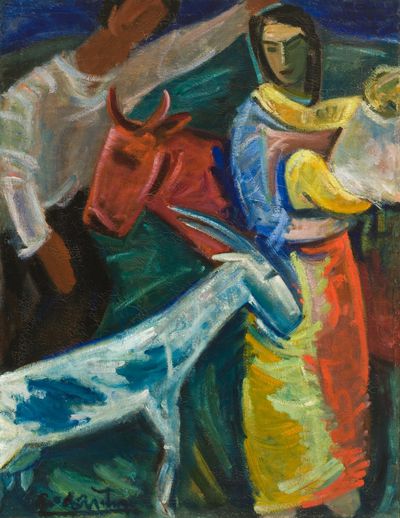Javascript must be enabled to continue!
Settlers
View through Europeana Collections
Antanas Gudaitis is one of the most eminent Lithuanian painters of the 20th century. During 1926-1929 he had studied literature at Kaunas University. In the meantime he also attended Justinas Vienožinskis courses at Kaunas Art School. In 1929 he left Lithuania for Paris in order to develop his drawing and painting skills. Until 1933 he had studied there at various private studios and at the National Conservatory of Arts and Crafts. Antanas Gudaitis was also one of the founders and an active member of the artists’ group “Ars”. His artworks rejected outdated rules of visual arts. He also tried to use aesthetics that would freely express feelings, emotions and perceptions of modern man. However, the major shift in Antanas Gudaitis painting style occurred in 1933-1934, when he returned from Paris. At that time he gradually given up on rational and clear method of painting he was using before. His artworks now contained more freedom, spontaneity, and drama. Painting “Settlers” was created during this transformation period. From the artistic point of view it is one of the most valuable artworks of Antanas Gudaitis from his early days. The painting is also important for the history of Lithuanian art. It illustrates the shift from academic and romantic realism styles, which in those days predominated artistic circles, towards more modern and expressive artistic language of shapes. The painting has an air of lightness about it evident in the brushwork and the colours; a taste probably acquired in Paris. In order to make an interesting colour combination the artist boldly painted goat in tones of blue and cow in tones of red. The characters and mood of the painting recall Parisian depictions of musicians and circus artists. Although, rather than reflecting the joy of life, anxiety and problems of young peasant couple are portrayed. Enjoyment of culture that Antanas Gudaitis acquired in Paris is gradually overshadowed by empathy for the less fortunate and sense of duty to society. In the eyes of contemporaries the title given to the painting turned this artwork into a reference toward a pressing problem in society, which is reflected both in art and literature of the period.
The Lithuanian National Museum of Art
Title: Settlers
Description:
Antanas Gudaitis is one of the most eminent Lithuanian painters of the 20th century.
During 1926-1929 he had studied literature at Kaunas University.
In the meantime he also attended Justinas Vienožinskis courses at Kaunas Art School.
In 1929 he left Lithuania for Paris in order to develop his drawing and painting skills.
Until 1933 he had studied there at various private studios and at the National Conservatory of Arts and Crafts.
Antanas Gudaitis was also one of the founders and an active member of the artists’ group “Ars”.
His artworks rejected outdated rules of visual arts.
He also tried to use aesthetics that would freely express feelings, emotions and perceptions of modern man.
However, the major shift in Antanas Gudaitis painting style occurred in 1933-1934, when he returned from Paris.
At that time he gradually given up on rational and clear method of painting he was using before.
His artworks now contained more freedom, spontaneity, and drama.
Painting “Settlers” was created during this transformation period.
From the artistic point of view it is one of the most valuable artworks of Antanas Gudaitis from his early days.
The painting is also important for the history of Lithuanian art.
It illustrates the shift from academic and romantic realism styles, which in those days predominated artistic circles, towards more modern and expressive artistic language of shapes.
The painting has an air of lightness about it evident in the brushwork and the colours; a taste probably acquired in Paris.
In order to make an interesting colour combination the artist boldly painted goat in tones of blue and cow in tones of red.
The characters and mood of the painting recall Parisian depictions of musicians and circus artists.
Although, rather than reflecting the joy of life, anxiety and problems of young peasant couple are portrayed.
Enjoyment of culture that Antanas Gudaitis acquired in Paris is gradually overshadowed by empathy for the less fortunate and sense of duty to society.
In the eyes of contemporaries the title given to the painting turned this artwork into a reference toward a pressing problem in society, which is reflected both in art and literature of the period.
Related Results
Tobacco pouch
Tobacco pouch
"362-22" "Two Bears Band, Fort Rice.″Yanktonai pipe bag; wool, glass, porcupine quills; l. 43.5/73 cm., w. 16.5 cm.; ca. 1860s.″Documentation: \Two Bears band, Fort Rice.‖ Purchase...
Ceremonial tobacco pouch
Ceremonial tobacco pouch
Pipe bag; Lakota; ca. 1870-1880 \nHide, glass beads, porcupine quills, pigments; l. 40 cm. (incl. fringe); w. 13 cm.\nRMV 3158-9; purchased from art dealer Leendert Van Lier, Amste...
Tobacco pouch
Tobacco pouch
Tobacco, smoking, ritual, pipes, tobacco bags Tobacco was a stimulant used by the indigenous people in large parts of North, Central and South America as a sedative, medicine again...
Powder bag and powder horn
Powder bag and powder horn
Engesle textThis powder bag; 1860-1870Hide, wool, glass, cow horn, wood; bag: h. 20.5 cm., w. 18 cm.\nRMV 710-7; Herman Ten Kate collection; purchased from Niagara Falls trader, 18...
Women's Layout
Women's Layout
CLOTHING AND ACCESSORIES: production and decoration The wealth of the Plains consisted of the immense bison herds. The bison didn't just provide food. The hide of this animal was u...
Women's Layout
Women's Layout
CLOTHING AND ACCESSORIES: production and decoration The wealth of the Plains consisted of the immense bison herds. The bison didn't just provide food. The hide of this animal was u...




